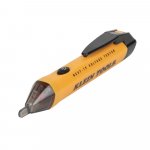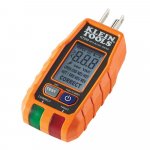I have an electrical issue that is driving me nuts. So any advice (hopefully correct advice LOL) would be appreciated. Been living in my house for over 15 years. House was built in the 40's but was heavily renovated in probably the mid-80's. (Important because house originally had no overhead lights, renovation installed some, including this fan/light, but with modern copper wiring, not the weird aluminum stuff). Right before Christmas I go into my bathroom and flip the switch for my exhaust fan/light and nothing happens - no light, no fan. Replaced the bulb just in case that would matter, nothing. Checked the circuit breaker - still good and everything else on the circuit is still fine. OK, fan is over 15 years old maybe it just died. It is just one of those typical Broan 8 1/2" square ones - nothing fancy. If you are familiar with those fans, inside the enclosure are 2 little outlets, one for the fan and one for the light. Mine is wired for both to be controlled by 1 switch.
I bought and replaced the whole fan/light, (looks literally exactly same as the old one) still doesn't work. I check to make sure it is getting power at the light itself - yes. hmmm maybe the wall switch is bad. So I had one on hand, replaced it. Still nothing. So I thought maybe I got a lemon from Home Depot. So I plugged in both the new fan part and the new light part into a different outlet. They both work fine! So on a whim I plugged the OLD fan and light into a different socket - BOTH work.
I find it hard to believe that the short (under 5') wire run from switch to fan could somehow go bad. But that's about the only thing I can think of. No mice/rodent or other problems that I am aware of that would cause a short in the wire. The only possible thing is that the wire runs next to my "chimney" - the cinderblock exhaust avenue for my gas furnace - not an actual fireplace chimney. It gets warm but not hot by any stretch. So what could possibly be wrong? Any ideas would be much appreciated.
I bought and replaced the whole fan/light, (looks literally exactly same as the old one) still doesn't work. I check to make sure it is getting power at the light itself - yes. hmmm maybe the wall switch is bad. So I had one on hand, replaced it. Still nothing. So I thought maybe I got a lemon from Home Depot. So I plugged in both the new fan part and the new light part into a different outlet. They both work fine! So on a whim I plugged the OLD fan and light into a different socket - BOTH work.
I find it hard to believe that the short (under 5') wire run from switch to fan could somehow go bad. But that's about the only thing I can think of. No mice/rodent or other problems that I am aware of that would cause a short in the wire. The only possible thing is that the wire runs next to my "chimney" - the cinderblock exhaust avenue for my gas furnace - not an actual fireplace chimney. It gets warm but not hot by any stretch. So what could possibly be wrong? Any ideas would be much appreciated.




